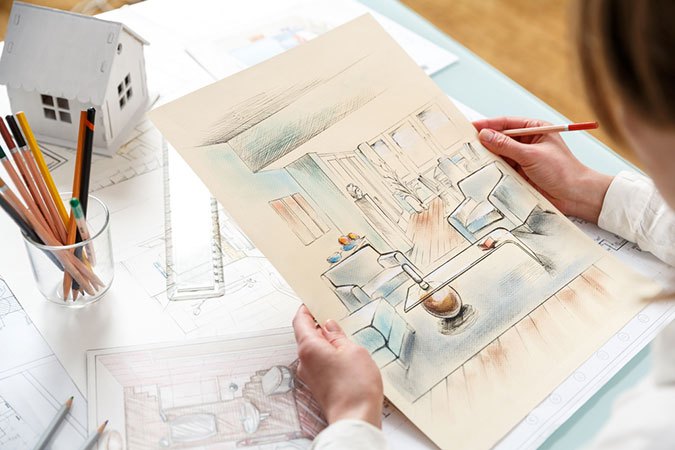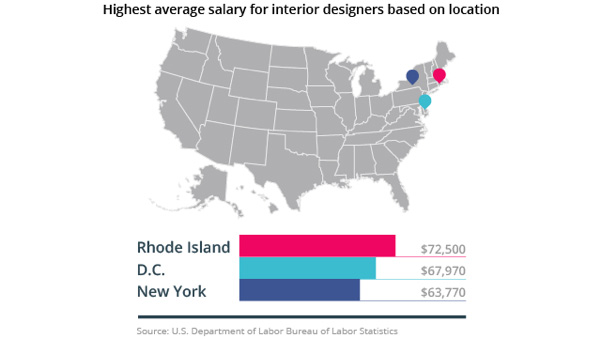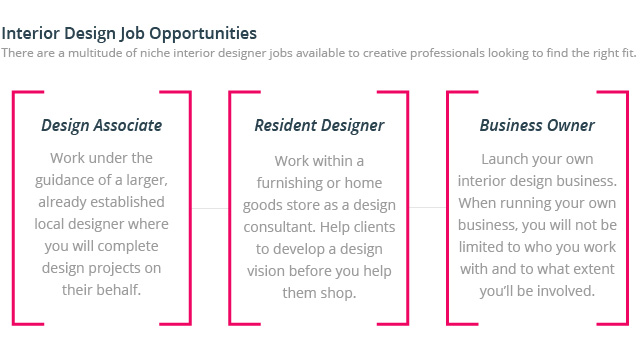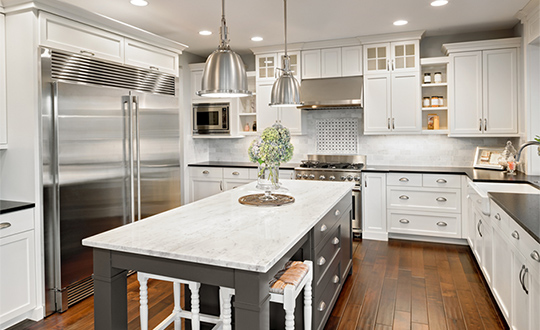
If you’re interested in becoming an interior designer, you probably have a ton of questions you want answered before you take the next step. From getting some formal educational training and becoming nationally certified to learning the marketing basics necessary to start your own business, there is a ton of knowledge available that all aspiring designers should take the time to discover before diving in. To help you get started with your research, we’ve outlined some answers to a few of the most common and important questions we’re asked by aspiring interior design professionals like you.
What Do Interior Designers Do?
On the most basic level, an interior designer is hired by clients to help envision, design, and execute beautiful, aesthetically pleasing and functional living or working spaces. Interior designers are hired every day across the globe to meet a number of different client needs in a variety of spaces- from homes and apartment redesigns to the development of large corporate workspaces or trendy restaurant interiors. From working in AutoCAD or hand drawing sketches of beautiful design visions to shopping for furniture and selecting the perfect matching paint, interior designers work from start to finish to ensure that a beautiful, practical space is created for their clients.
Interior Designer Job Duties and Responsibilities
While the duties and responsibilities of an interior designer can vary based on who they work for, the project they’re working on, and the clients they are working with, typically they’re most often responsible for;
- Searching for and bidding on new projects
- Working with clients to determine their goals, budget, and requirements for a project
- Sketching preliminary design plans
- Meeting with clients to go over ideas and plans, and agreeing on what plans to move forward with
- Advising clients on the best design concepts for their space and budget
- Ordering materials and overseeing installation of design elements
- Creating project timelines and estimating costs
Skills Interior Designers Should Have
To be a successful interior designer, you’ll want to have a certain set of skills, including;
- Creativity
- Problem-solving
- Customer service skills
- Technical and digital skills
- Visual awareness
- Time management
What is Interior Design?
From furniture styles and fabrics to color palettes and lighting installations, there are many different facets of the interior design field, all worth getting some formal training in before you launch a legitimate career and start working with clients. Interior design is generally a combination of both creativity and technical skills. Applied in both residential and commercial projects, these aesthetic skills come together to create beautifully designed indoor and outdoor environments.
Read more about what interior design really is.
How Much is an Interior Designer's Salary?

According to the Bureau of Labor Statistics, the average salary for interior designers is around $60,340.
However, as is true of all industries, level of experience, formal educational training, certification, and geographical and local demographic factors all play a key role in determining how much each individual interior designer may get paid. So, if you work as an interior designer with clients in a more metropolitan area for example, you could expect to make more than the average salary, while someone working in a more rural area with less demand for interior design may earn less.

Not only that, the specific type of interior design work you do will have an impact on your salary as well. For example, interior designers who work in the architecture and engineering industry specifically have the highest annual median wage according to the BLS’s research, earning an average of $63,210 per year.
Learn more about where interior designers make the most money across different sectors of the industry.
Do I Need an Interior Design Degree?
It depends! While not all interior designers will require a degree to find a job in the field, some do, and some states may even have specific education and experience requirements to qualify for a license. It’s important to check your state’s specific regulations on interior designers before choosing what kind of education or training you’ll pursue!
While some colleges and universities offer full, 4-year long undergraduate degree programs in the field of interior design, these programs are by no means the only options available to help you prepare to become an interior designer.
While in the past, a bachelor’s degree was the usual path toward working in the field – some employers may still even prefer to hire those designers who do have a bachelor’s degree – today, more and more jobs look more for demonstrated skill and experience over formal education. That could mean it’s entirely possible to become an interior designer by taking a few different courses and stacking your skills, then getting some on-the-job experience. Or, if you want a more formal training experience but don’t necessarily want to get a college degree, that could mean taking an online course like NYIAD’s Interior Design Program.
For NYIAD students, courses can be completed online and from anywhere in the world as long as students have access to the internet and some extra time they can devote to their studies. As soon as students enroll, they receive an email from the school with login information and a link where they can click to login to the online learning center and begin studying.
The course itself includes video, audio, and text lessons that can be reviewed at the student’s preferred pace. At the end of each unit, our students also complete a project that is then submitted to the school and evaluated by our network of interior design mentors. In less than a year, students can prepare to take their first steps toward becoming professional interior designers!
Read a full outline of NYIAD's interior design course curriculum.
Can I Get Certified in Interior Design?
In addition to an interior design education, many students also feel more comfortable and prepared if they also get certified by a larger industry organization.
While this is by no means required of designers looking to start a business, it is simply an industry credential that can be used to gain experience, showcase expert training and bolster a resume.
For those interested in pursuing the certification route, note that the NYIAD interior design course has been completely certified by the Designers Society of America, an industry organization made specifically for all professional designers and trade partners.

With a membership of nearly 32,000 designers, showroom hosts and other industry members, DSA is a respected design community open to residential interior designers, space planners, kitchen and bath designers, re-designers, and the trade companies that serve them. Not only does membership help set apart more well-trained designers from the competition, but it also offers a multitude of networking opportunities, consultations, and individual promotion.
Every NYIAD Interior Design student and graduate is eligible for DSA's Residential Interior Design Qualification Certification (RIDQC).

Learn more about how to purse your interior design certification.
Do Interior Designers Need to Complete Internships?
Although interior designers are not required to complete formal internships as part of their educational training, working hands-on in the field is an invaluable experience that we highly recommend students take advantage of if given the opportunity.
When it comes to determining whether a certain career path is the right fit for you, there’s nothing like actually having the chance to try working in the field in real life to help you determine how you feel about a line of work.
Browse NYIAD’s guide on interior design internships or interior design apprenticeships.
What’s the Difference Between an Interior Design Certificate and Degree?
There are no requirements for interior designers to receive a college or university diploma in order to start their own business, get hired at design firms, or start working with clients. The only case in which a diploma may be required is if you're looking to do extremely large-scale design projects for commercial clients (think a large corporate office in a metropolitan area).
Essentially, asking whether it’s required for an interior designer to have a university degree is similar to asking whether you need a writing degree in order to be a writer. While investing in a college education in writing (or design) is no doubt a rewarding pursuit, it’s also expensive and time consuming- and countless writers have successful, rewarding careers without one. In creative fields such as these, it's more of a personal choice.
Which Is Right for Me: A Certificate or Degree?
Deciding which path is the right one for you when you’re considering a new career can seem confusing. How do you decide whether an interior design certificate or degree is the best choice for you? Consider a few things to help you narrow down your options:
- How much time do I want to dedicate to learning new skills? A degree will take you years to complete, while a certificate or diploma program can most usually be finished in a year or less.
- How much time do I have to study? A four-year degree may require you to attend scheduled class times and be more demanding of your time, whether you take it in-person or online. A course like NYIAD’s Interior Designer Program is self-paced and allows you to study around your schedule, instead of scheduling your life around your studies.
- How much do I want to pay? College is expensive. A certificate program is often less so. If you don’t want to deal with student loans or expensive tuition, a more affordable online certificate could be the better fit for you.
- What do I want to learn? A benefit of a four-year college education is that it’s designed to be well-rounded. You won’t just focus on interior design classes; you’ll also have general education courses that cover a wide range of subjects. However, if you want to focus solely on design classes, a certificate program could be the right fit.
Read more details on the difference between an interior design certificate and degree.
What Kind of Interior Design Job Opportunities Are There?
There are several different kinds of interior design jobs out there, so there are plenty of opportunities for students to find their niche.
One option for students to consider after graduating is to work under the guidance of a larger, already established local designer. Within this role, which is referred to as “design associate” you would handle specific projects under the larger umbrella in association with that firm’s name (like completing projects on their behalf). If this is a starting place that sounds right for you, we recommend that you approach the head designer of a local firm you’re interested in and offer him or her a proposal. It’s important that you emphasize your genuine interest in getting some guidance and supervision as well as describe why you wanted to work at this firm specifically.

Another career route involves working as a “resident designer” of sorts who works within a furnishing or home goods store. Within this role, you would work as a sort of “design consultant” who helps clients pick out pieces and arrange them nicely in whatever given space they’re looking to update, all the while helping the store you work for increase sales. Sometimes in this role, you’ll have an office or desk space within the store itself, but will often travel to clients’ homes to actually walk around the space and help develop a design vision before you help them shop.
Beyond that, one of the most common career paths chosen by NYIAD students is to simply launch your own interior design business. When running your own business, you will not be limited by the direction of upper management dictating who you work with and to what extent you’ll be involved. As the director of your own firm, you can find clients of your own, draw up your own interior design agreements and execute all the planning entirely independently.
What's the Difference Between Residential and Commercial Design?
Residential designers are designers who plan and decorate spaces inside of client homes. Most often, residential designers also specialize in an additional niche of residential design. For example, you might be a residential interior designer with a specialization in kitchen decorating or custom furniture design.
Residential designers can also make larger scale recommendations to their clients- things like the addition or elimination of entire walls, installation of a skylights, maybe new flooring and floor design, trim work, an exciting light installation- the list goes on.
Read more about the difference between residential and commercial interior design
Commercial designers on the other hand plan and design business places- offices, small local businesses, restaurants, stores, etc. Similar to residential designers, commercial designers also often choose a specialization. For example, if you are a commercial designer and have been practicing for a number of years, completing different projects for different clients, you might find you prefer restaurant redesign projects, and declare it as your specialty.
What Should I Include in My Interior Design Resume?
In addition to developing an interior designer resume that lists where you’ve gone to school, when you graduated, which interior design certifications you’ve earned and any design projects you’ve completed in the past, it’s also crucial for you to create a beautiful portfolio showcasing your work. One of the most important things every aspiring creative professional needs to do when it comes time to apply for jobs or approach new clients is to develop a cohesive, organized interior design portfolio.
How to Make an Interior Design Portfolio
Traditionally, a portfolio like this would be some type of loose-leaf presentation you could walk through with your potential employers or your interested clients. This should include pictures of your work as well as any type of publicity write-ups or happy client testimonials you could offer for reinforcement of your capabilities and knowledge. It should also always include a copy of your New York Institute of Art and Design Certificate of Graduation at the end to reinforce the fact that you are a formally educated professional. Some designers use leather or plastic-bound portfolio cases filled with laminated copies of all these credentials.
If you’re more interested in modernizing your portfolio, you could also scan images of your sketches and develop a magazine-style layout of your process (sketches, layouts, finished work, etc.). With this method, you can create one collage-type layout, print multiple copies of it and have the ability to leave said copies with individual clients as you meet new people.
Finally, you can also digitally place your portfolio on your website, social media or blog if you’re active on any of these three. If you’re developing a website to showcase your portfolio, we recommend that you divide your work into categories differentiating all the different jobs you have completed, specifically featuring key whole-room and vignette shots.
How to Start an Interior Design Business
If you’re seriously interested in starting your own interior design business, it’s important to first develop the comprehensive knowledge necessary in order to call yourself an industry expert and start professionally consulting with paying clients. From historical design trends and color theory to furniture styles and fabrics, there is a multitude of information you’ll need to master as a capable, proficient designer in the industry.
Read more about the formal educational interior design training needed to start a legitimate career.
How Do I Find Interior Design Clients?
Once you’ve completed an interior design course or certification program and you’re ready to dive in and start working, it can be daunting to consider how you’ll actually find people around your area that will employ your services.
NYIAD’s interior design course has an entire final section of the curriculum entirely devoted to training our students on the marketing and business skills necessary to develop a working client base. In our Promotion and Sales Techniques unit for example, we talk things like developing a portfolio and creating your first professional website. Not only that, we’ll go over all the intricate details of effective marketing and promotion as we teach you to get your first legitimate business on its feet.
Read a full outline of the interior design business unit of our course.
How Do I Develop Interior Design Contracts with Those Clients?
Once you’ve developed all the marketing skills necessary to find new clients for your business, it’s also crucial for you to effectively draw up professional contracts with said buyers. Without this formal, written agreement, payment coordination can become sloppy and complicated, miscommunications can take place, and the business aspect of the transaction could quickly become incoherent and disorganized, making your life as a businessperson more complicated and potentially damaging your reputation among new clients.
Generally, there are 5 key things all designers need to consider when forming first letters of agreement. Browse a list of the best points to include in your interior design contract.
How to Become an Interior Designer Online
The first step toward becoming an interior designer online is finding and enrolling in the training program that best fits your goals. With NYIAD’s self-paced, online Interior Design Program, you can take the first step toward a new career whenever you’re ready. There are no applications to fill out or deadlines to meet – just enroll, make your first tuition payment, and start your first class! For help on getting started or to answer any questions you may still have about becoming an interior designer, reach out to our dedicated admissions team at 1-800-583-1742.



